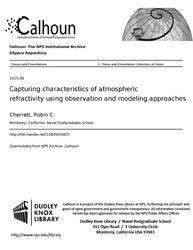File:Capturing characteristics of atmospheric refractivity using observation and modeling approaches (IA capturingcharact1094545825).pdf

Original file (1,275 × 1,650 pixels, file size: 6.52 MB, MIME type: application/pdf, 208 pages)
Captions
Captions
Summary[edit]
| Capturing characteristics of atmospheric refractivity using observation and modeling approaches
( |
||
|---|---|---|
| Author |
Cherrett, Robin C. |
|
| Title |
Capturing characteristics of atmospheric refractivity using observation and modeling approaches |
|
| Publisher |
Monterey, California: Naval Postgraduate School |
|
| Description |
Electromagnetic wave propagation is sensitive to gradients of refractivity derived from atmospheric temperature, humidity, and pressure. It is thus critical to understand the atmospheric conditions leading to the formation of the gradient layers and explore methods to better represent the gradients in forecast models. This study first examines the sensitivity of the surface evaporative ducts to key physical parameters of the atmospheric surface layers. This analytical study is followed by analyses of relationships between the ducting/propagation variables and air-sea interaction parameters using input from buoy-based measurements in diverse meteorological conditions. We further explore numerical simulations using a single column model (SCM) forced by the 3-dimensional Coupled Ocean- Atmosphere Mesoscale Prediction System (COAMPS). This hybrid modeling approach leverages the mesoscale model’s strength to provide large-scale forcing while using high vertical resolution simulations to capture the strong gradient layers. The SCM approach works effectively for the stratocumulus-topped boundary layers. Its performance for the cloud-free cases from Trident Warrior 2013 was limited due to the complexity of external forcing in coastal regions. A new blending technique is developed based on SCM to effectively patch the surface evaporative duct to forecasts from COAMPS with consistent model physics throughout the entire atmospheric column. Subjects: Propagation; surface layer; boundary layer; air-sea interaction; flux parameterization; COAMPS; single column model |
|
| Language | English | |
| Publication date | June 2015 | |
| Current location |
IA Collections: navalpostgraduateschoollibrary; fedlink |
|
| Accession number |
capturingcharact1094545825 |
|
| Source | ||
| Permission (Reusing this file) |
This publication is a work of the U.S. Government as defined in Title 17, United States Code, Section 101. Copyright protection is not available for this work in the United States. | |
Licensing[edit]
| Public domainPublic domainfalsefalse |
This file is a work of a sailor or employee of the U.S. Navy, taken or made as part of that person's official duties. As a work of the U.S. federal government, it is in the public domain in the United States.
|
 | |
| This file has been identified as being free of known restrictions under copyright law, including all related and neighboring rights. | ||
https://creativecommons.org/publicdomain/mark/1.0/PDMCreative Commons Public Domain Mark 1.0falsefalse
File history
Click on a date/time to view the file as it appeared at that time.
| Date/Time | Thumbnail | Dimensions | User | Comment | |
|---|---|---|---|---|---|
| current | 10:49, 15 July 2020 |  | 1,275 × 1,650, 208 pages (6.52 MB) | Fæ (talk | contribs) | FEDLINK - United States Federal Collection capturingcharact1094545825 (User talk:Fæ/IA books#Fork8) (batch 1993-2020 #10873) |
You cannot overwrite this file.
File usage on Commons
The following page uses this file:
Metadata
This file contains additional information such as Exif metadata which may have been added by the digital camera, scanner, or software program used to create or digitize it. If the file has been modified from its original state, some details such as the timestamp may not fully reflect those of the original file. The timestamp is only as accurate as the clock in the camera, and it may be completely wrong.
| Short title | Capturing characteristics of atmospheric refractivity using observation and modeling approaches |
|---|---|
| Author | Cherrett, Robin C. |
| Software used | Cherrett, Robin C. |
| Conversion program | Acrobat Distiller 11.0 (Windows) |
| Encrypted | no |
| Page size | 612 x 792 pts (letter) |
| Version of PDF format | 1.4 |

